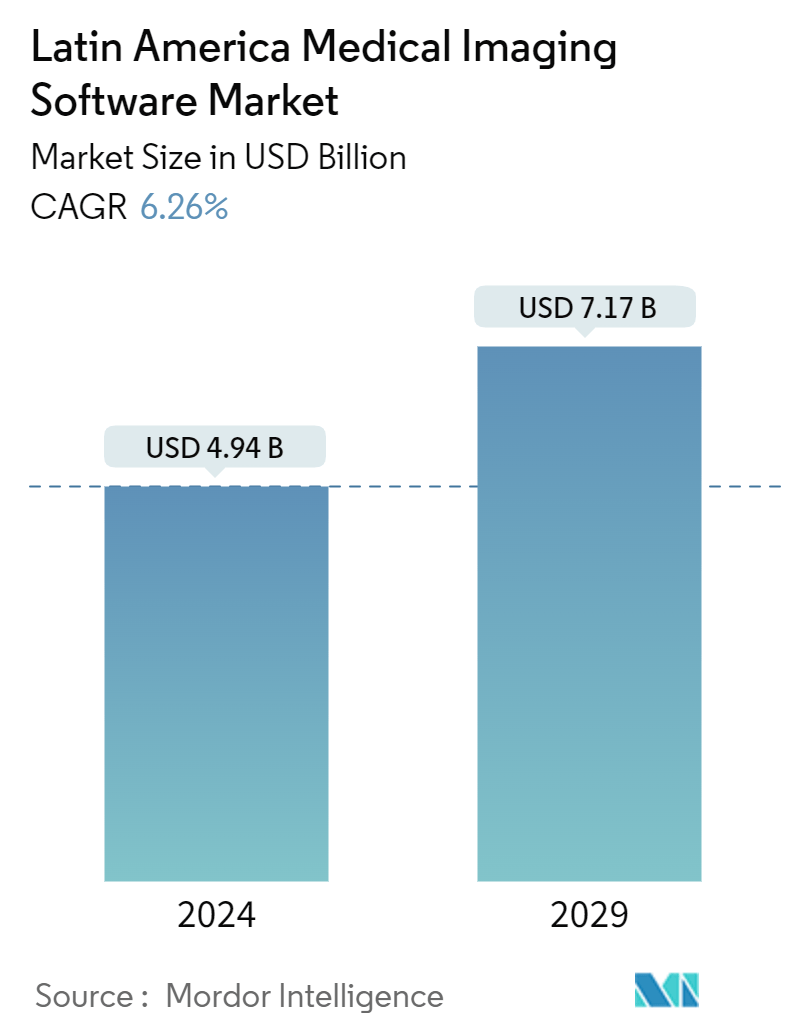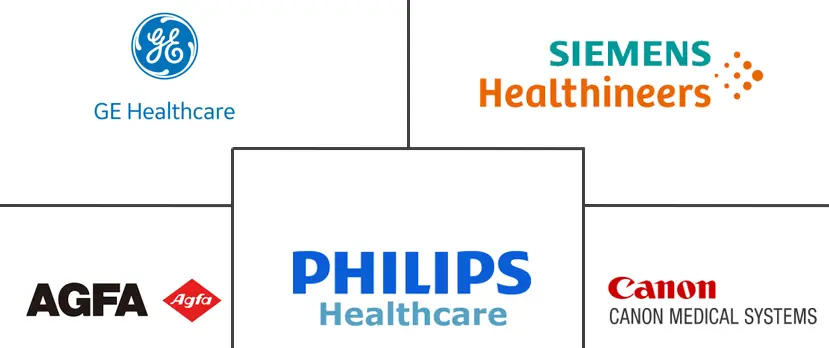Market Size of Latin America Medical Imaging Software Industry

| Study Period | 2019 - 2029 |
| Base Year For Estimation | 2023 |
| Market Size (2024) | USD 4.94 Billion |
| Market Size (2029) | USD 7.17 Billion |
| CAGR (2024 - 2029) | 6.26 % |
| Market Concentration | Medium |
Major Players
*Disclaimer: Major Players sorted in no particular order |
Latin America Medical Imaging Software Market Analysis
The Latin America Medical Imaging Software Market size is estimated at USD 4.94 billion in 2024, and is expected to reach USD 7.17 billion by 2029, growing at a CAGR of 6.26% during the forecast period (2024-2029).
In coming years, the market expansion is expected to be driven by the growing capabilities of medical imaging software that is made accessible through the integration of AI and ML technologies. These technologies could assist in automating tasks, detecting anomalies, and improving the accuracy of diagnoses, making them a significant driver of market growth.
- Medical imaging is a technique, process, and art of creating visualizations of the interior of a body that helps in clinical diagnosis and medical intervention. It seeks to reveal internal structures as well as diagnose and treat disease. These software programs are made to process, examine, view, and manage medical images generated by a variety of imaging modalities, including X-ray, ultrasound, Computed Tomography (CT), Magnetic Resonance Imaging (MRI), and Positron Emission Tomography (PET). As a result, these software programs are crucial for enhancing the planning of medical treatment, effectiveness of diagnosis, and patient outcomes.
- The demand for medical imaging software is rising because of advancements in medicine and healthcare. The growing need for medical image software in the region is currently supported by the growing use of electronic health records to store, share, and manage patient health information in the format of images.
- Additionally, due to the expansion of healthcare IT infrastructure, including electronic health records (EHR) systems and picture archiving and communication systems (PACS), the industry's demand for software solutions that smoothly interface with these platforms to enable effective data exchange and storage is rising. As a result, developments in healthcare IT-related infrastructure might act as a significant market driver.
- However, the equipment set-up cost could be higher, restraining the market growth. At the same time, the handling of this software requires skilled professionals. The need for more skilled medical professionals is one of the factors affecting the market.
Latin America Medical Imaging Software Industry Segmentation
Medical Imaging includes a set of several different technologies that are used to view the human body in order to diagnose, monitor, or treat medical conditions. Each type of technology gives different information about the area of the body being studied or treated, related to possible disease, injury, or the effectiveness of medical treatment.
The Latin America medical imaging software market is segmented by imaging type (2d imaging, 3d imaging, and 4d imaging), application (dental applications, orthopedic applications, cardiology applications, obstetrics and gynecology applications, mammography applications, urology and nephrology applications, and other applications), and country (Brazil, Argentina, Mexico, Chile, and Rest of Latin America). The market sizes and forecasts are provided in terms of value in USD for all the above segments.
| By Imaging Type | |
| 2D Imaging | |
| 3D Imaging | |
| 4D Imaging |
| By Application | |
| Dental Applications | |
| Orthopaedic Applications | |
| Cardiology Applications | |
| Obstetrics and Gynaecology Applications | |
| Mammography Applications | |
| Urology and Nephrology Applications | |
| Other Applications |
| By Country | |
| Brazil | |
| Argentina | |
| Mexico | |
| Chile |
Latin America Medical Imaging Software Market Size Summary
The Latin America medical imaging software market is poised for significant growth, driven by advancements in artificial intelligence and machine learning technologies that enhance the capabilities of medical imaging software. These technologies facilitate automation, anomaly detection, and improved diagnostic accuracy, which are crucial for the market's expansion. Medical imaging software plays a vital role in clinical diagnosis and intervention by processing and managing images from various modalities such as X-ray, ultrasound, CT, MRI, and PET. The increasing integration of electronic health records and healthcare IT infrastructure, including PACS, further propels the demand for these software solutions, as they enable efficient data exchange and storage. However, the high setup costs and the need for skilled professionals pose challenges to market growth.
Brazil stands out as a key player in the region, supported by its robust healthcare infrastructure and substantial investment in healthcare technologies. The country's growing geriatric population and the prevalence of chronic diseases drive the demand for advanced medical imaging software. The Brazilian government's significant healthcare expenditure creates a conducive environment for adopting these technologies. The market is moderately consolidated, with major global players like Siemens Healthcare, Philips Healthcare, and GE Healthcare Inc. leading the way. Recent expansions and collaborations, such as those by Coreline Soft, JLK, Agfa, and Lunit, highlight the dynamic nature of the market, as companies strive to enhance their product offerings and expand their presence in Latin America.
Latin America Medical Imaging Software Market Size - Table of Contents
-
1. MARKET INSIGHTS
-
1.1 Market Overview
-
1.2 Industry Value Chain Analysis
-
1.3 Industry Attractiveness - Porter's Five Forces Analysis
-
1.3.1 Bargaining Power of Suppliers
-
1.3.2 Bargaining Power of Buyers
-
1.3.3 Threat of New Entrants
-
1.3.4 Threat of Substitutes
-
1.3.5 Intensity of Competitive Rivalry
-
-
1.4 Assessment of the Impact of COVID-19 on the Market
-
-
2. MARKET SEGMENTATION
-
2.1 By Imaging Type
-
2.1.1 2D Imaging
-
2.1.2 3D Imaging
-
2.1.3 4D Imaging
-
-
2.2 By Application
-
2.2.1 Dental Applications
-
2.2.2 Orthopaedic Applications
-
2.2.3 Cardiology Applications
-
2.2.4 Obstetrics and Gynaecology Applications
-
2.2.5 Mammography Applications
-
2.2.6 Urology and Nephrology Applications
-
2.2.7 Other Applications
-
-
2.3 By Country
-
2.3.1 Brazil
-
2.3.2 Argentina
-
2.3.3 Mexico
-
2.3.4 Chile
-
-
Latin America Medical Imaging Software Market Size FAQs
How big is the Latin America Medical Imaging Software Market?
The Latin America Medical Imaging Software Market size is expected to reach USD 4.94 billion in 2024 and grow at a CAGR of 6.26% to reach USD 7.17 billion by 2029.
What is the current Latin America Medical Imaging Software Market size?
In 2024, the Latin America Medical Imaging Software Market size is expected to reach USD 4.94 billion.

